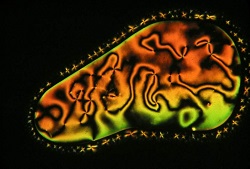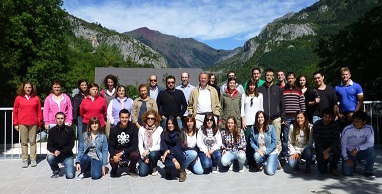Brief History

Research on liquid crystals started at the University of Zaragoza in 1975 under the direction of Professor Enrique Meléndez in the Organic Chemistry Department of the university. From the beginning, works in this field were undertaken through a multidisciplinary approach, and soon collaborations with internationally renowned groups, such as the Liquid Crystals Group of Orsay, pioneers both in ferroelectric liquid crystals and characterization of mesogenic materials using X-ray diffraction, were established. Soon after, joint research projects were established with national groups belonging to the Departments of Applied Physics and Condensed Matter Physics from the University of the Basque Country (UPV) in the Campus of Leioa (Vizcaya) and a group of the Photonics Technology Department of the ETSI Telecommunications of the Polytechnic University of Madrid (UPM).
The group's research focused initially on the study of the structure-activity relationship of low molecular weight materials, but soon two new lines of work began. The first one dealt with Polymer Liquid Crystals in collaboration with the Company Cables de Comunicaciones SA. The second one was centered in Ferroelectric Liquid Crystals and was developed within a collaboration with groups in Physics at the UPV mentioned above.
The CLIP group was a former research group of the Institute of Materials Science of Aragon (ICMA), which is a joint Institute between the University of Zaragoza and the Spanish Council for the Scientific Research (CSIC). The group was directly involved in the foundation of the ICMA in 1985. Within the Institute, two internal partnerships, fundamental for the development of the research of the group, were established. The first one was founded on the field of liquid crystals known as Metal-Organic Materials, i.e. Metallomesogens. This collaboration took place with two groups of the Inorganic Chemistry department-ICMA and gave rise to the first European project in which our group participated. This project was leaded by Professor Maitlis of the University of Sheffield, UK. As a result of the work in this field were published some review papers and a monographic book. The second partnership was set up with a group of physicists of Condensed Matter Physics department-ICMA and was devoted to the study of liquid crystal polymers for optical applications. The development of the research in both fields led to the association with Philips Research Ltd. and Merck Ltd. Within the frame of two subsequent European projects.
 The evolution of the group's research on the above issues has led the current research lines, which appear in the description of the group. Indeed, the former research line in polymer liquid crystals gave rise to two lines of work focused on Functional Polymers, very active and multidisciplinar, and in Liquid Crystal Dendrimers (Dendromesogens) in which our group has international recognition, having published some reviews upon invitation.
The evolution of the group's research on the above issues has led the current research lines, which appear in the description of the group. Indeed, the former research line in polymer liquid crystals gave rise to two lines of work focused on Functional Polymers, very active and multidisciplinar, and in Liquid Crystal Dendrimers (Dendromesogens) in which our group has international recognition, having published some reviews upon invitation.
The work involving low molecular weight liquid crystals self-organized into four research lines. Former research devoted to calamitic ferroelectric liquid crystals evolved into banana mesogens. This line is being developed together with physicists at the UPV. Another important research interest is the formation and control of chiral helical columnar organizations using approaches based on supramolecular interactions. The work on metallomesogens is still a part of the group research and a new line, based on the study of crystalline or liquid crystalline chiral organizations from achiral molecules, has recently begun.
Recently, the group opened a new area of research in biomedicine with two main interests: drug delivery and tissue engineering. Both lines are being developed thanks to the collaboration with groups from the Aragon Institute of Nanoscience (INA) and Engineering Research Institute of Aragon (I3A) within different research projects such as Consolider-Ingenio, ITN Marie-Curie, DGA and PAMER projects.